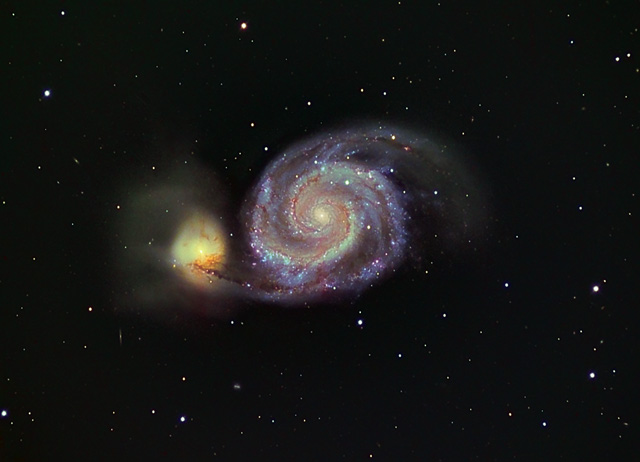| Time Travel Research Center © 2005 Cetin BAL - GSM:+90 05366063183 - Turkey / Denizli | |||
|
|
|||
|
M51 Galaxy
|
||
|
CANES VENATICI - SPIRAL GALAXY - MAGNITUDE 8.4 |
|||

M51 - THE WHIRLPOOL GALAXY IN CANES VENATICI
|
About this Object: |
|
One of the brightest
galaxies in the sky, M51 sits next to its companion galaxy NGC 5195 to
form the most famous galactic pair. Under dark and transparent skies,
M51 can be considered a binocular object. Not bad for an object that is
approximately 23 million light years away. The crossing of NGC 5195 in
its path causes M51 to burn with new, blue supergiant stars which appear
as clusters in the galaxies arms. An 8" telescope in dark skies will
easily show the spiral arm structure. It is one of the easiest galaxies
to find, lying a few degrees below Alkaid, the end star in the hand of
the Big Dipper. |
Location:
Ballauer Observatory
near Azle, Texas
Date: April 1, 2005 (luminance) & April 2, 2005 (RGB)
Seeing:
9/10 (luminance) & 2/10 (RGB)
Transparency: 5/10; 4.5 magnitude ZLM
Temperature: 35 degrees F, -25c at the camera (luminance) and
53 degrees F, -23c at the camera (RGB)
Scope/Mount: 12.5" RCOS Ritchey-Chretien (with FFC) and Tak
NJP mount
Camera: SBIG STL-6303e astro CCD camera (60 minutes of
luminance taken with the SBIG STL-11000M)
Exposure Info: LLRGB image; 160:30:30:55 minutes (10 min subs
for Luminance; 5 minute subs for RGB binned 2x2))
Processing
Information:
Dark frame calibration,
registration, and DDP in MaxIm DL 4. Lucy-Richardson Deconvolution (2
iterations) in CCDSharp on luminance. RGB and LRGB combine (multiple
iterations, cropping, artificial flats, levels/curves, sharpening, and noise
removal (despeckle, gaussian blur, dust/scratches) in Photoshop CS. Further
noise removal using DSLR Tools v.1.5 Photoshop plug-in (thanks to Noel
Carboni).
Notes: A "miracle" image, salvaged from poor information. First time to use the RC with the Tak NJP mount. Plus, I haven't gotten the optical astigmatism (and field curvature) under control with the RC yet!
Good seeing for luminance, though guiding with the NJP mount needs improvement (2.2" to 2.5" FWHM stars after 10 minute subs in 1.2" seeing skies). First 100 minutes of luminance taken with STL-6303, whereupon it frosted over. Remaining 60 minutes of luminance taken with STL-11000, whereupon it TOO frosted over! Fully more than 60% of the total luminance subexposures used for this image showed frosting over more than 30% of the image area, and that doesn't include the other 2 hours of exposures that I couldn't use. Therefore, because I couldn't get an even background through flat fielding, I was going to discard this data. Instead, I cropped the image and applied processing to try to flatten the background artificially - if you've seen a frost-affected image, you know how hard that is! The result was a somewhat respectable luminance image.
The next night, when I took the RGB, I endured some horrible seeing and battled a run-away RA problem with the Tak mount - perhaps a coincidence that daylight savings time occurred during this exposure set? Who knows? Anyway, I wound up with a shortened blue data set. To make matters worse, I couldn't get my camera temperature to the full -25c. Therefore, I had to scale the darks with bias frames - the first time I've ever done that, and I think I did it wrong. So the RGB was horribly noisy, though thank goodness for Sigma combine, generous amounts of blurring, and despeckling in Photoshop. Used several iterations of LLRGB blending to buildup/clean up the bad color data.
Needless to say, having brought this image back from the dead, I'm pleased with the results!
Astronomi Galaxy Resimler Nebula Resimler Yıldız Resimleri
Copyright(c) 2003 - 2006 - Cetin BAL. All rights reserved.